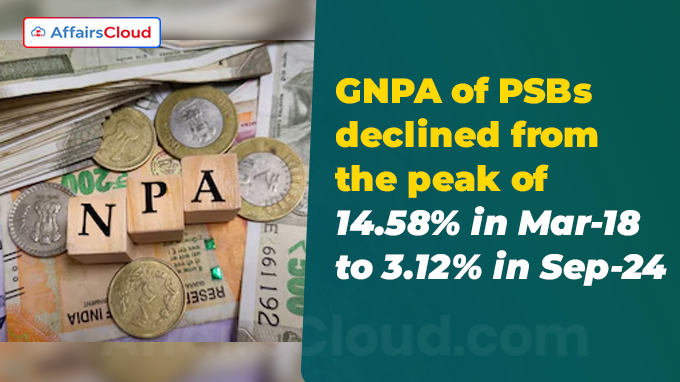 According to the Ministry of Finance (MoF) official data released in December 2024, Gross Non-Performing Asset (GNPA) ratio of Public Sector Banks (PSBs) have decreased to a decade low from a peak of 14.58% March 2018 to 3.12% in September 2024.
According to the Ministry of Finance (MoF) official data released in December 2024, Gross Non-Performing Asset (GNPA) ratio of Public Sector Banks (PSBs) have decreased to a decade low from a peak of 14.58% March 2018 to 3.12% in September 2024.
- It cited that this significant improvement in GNPA ratio of PSBs is due to measures like the 4Rs (Recognition, Recapitalisation, Resolution, and Reform) undertaken by the Government of India (GoI), since 2015.
- Over the last 9 years, GoI introduced various policy reforms, which helped to improve the financial health and robustness of the banking sector including PSBs.
Key Improvements in PSBs:
i.The data revealed that PSBs have reported the highest ever cumulative net profit of Rs 1.41 lakh crore during the Financial Year 2023-24 (FY24) compared to the net profit of Rs 1.05 lakh crore in FY23.
ii.PSBs have registered net profit of Rs 0.86 lakh crore in the 1st Half (H1: April-September) of FY25.
- It further showed that PSBs have paid a total dividend of Rs 61,964 crore during the last 3 years.
iii.Capital to Risk-Weighted Assets Ratio (CRAR) of PSBs have improved by 393 basis points (bps), from 11.45% (in March 2015) to 15.43% (in September 2024).
iv.The gross advances of Scheduled Commercial Banks (SCBs) have significantly increased from Rs 8.5 lakh crore to Rs 61 lakh crore during 2004-14, which further surged to Rs 175 lakh crore in Mar-24.
Note: RBI initiated Asset Quality Review (AQR) in 2015 to identify and address the issue of stress in the banking system.
Key Initiatives led by GoI to Strengthen Financial Inclusion in India:
i.So far, 54 crore Jan Dhan accounts were opened and over 52 crore collateral-free loans under GoI’s various flagship Financial Inclusion (FI) schemes like Stand-Up India, Prime Minister Street Vendor’s AtmaNirbhar Nidhi (PM SVANidhi), PM Vishwakarma, among others, have been sanctioned.
- Under the Mudra and PM-SVANidhi scheme, 68% and 44% of total beneficiaries are women, respectively.
ii.The number of bank branches in India have increased from 1,17,990 (in Mar-14) to 1,60,501 (in Sep-24). Of 1, 60,501 branches, 1, 00, 686 are located in Rural and Semi-Urban (RUSU) areas of the country.
iii.Kisan Credit Card (KCC) scheme which was introduced in 1998, with the primary objective of providing a short-term crop loan to farmers. As on September 2024, total number of operative KCC accounts was at 7.71 crore with total outstanding amount of Rs 9.88 lakh crore.
iv.The GoI has consistently provided financial support to Micro, Small and Medium Enterprises (MSME) sector in terms of loans at affordable rates through various initiatives.
- The MSME advances reported a Compounded Annual Growth Rate (CAGR) of 15% during the last 3 years. The data showed that as on 31st March 2024, total MSME advances was at Rs 28.04 lakh crore, with an annual growth of 17.2%.
Key Welfare Measures for PSB Employees:
i.With the implementation of 12th Bipartite Settlement (BPS), the bank employees received a 17% hike in salary and allowance (Rs 12,449 crore)including a load of 3% (Rs 1,795 crore).
ii.Change in base year to 2016 for working out Dearness Allowance/Dearness Relief (AICPI for Industrial workers on base 2016) by replacing the existing base year, i.e. 1960
iii.Staff Welfare Fund (SWF) is a fund allocated by the PSBs for the welfare-related activities of working and retiring employees of PSBs.
- SWF was last revised in 2012 and since then, the combined maximum annual expenditure of SWF for all 12 PSBs has surged from Rs 540 crore to Rs 845 crore in 2024.
Important Terms:
i.GNPA Ratio: It is the total value of loans that are unpaid and have been classified as Non-Performing Asset (NPA) by a bank or Financial Institution (FI).
ii.CRAR also referred as Capital Adequacy Ratio (CAR). It is the ratio of bank’s capital relative to its risk-weighted assets and current liabilities. It is used to measure the ability of banks to withstand losses. Indian public sector banks must maintain a CRAR of 12%.
About Ministry of Finance (MoF):
Union Minister- Nirmala Sitharaman (Rajya Sabha- Karnataka)
Minister of State (MoS)- Pankaj Chaudhary (Constituency- Maharajganj, Uttar Pradesh, UP)




